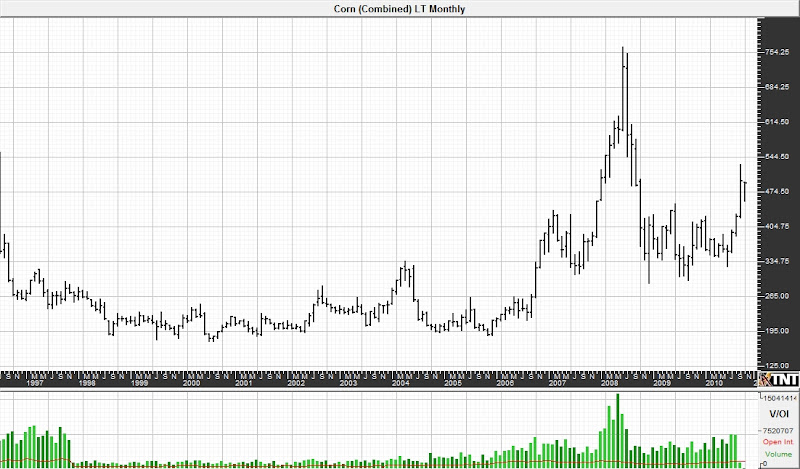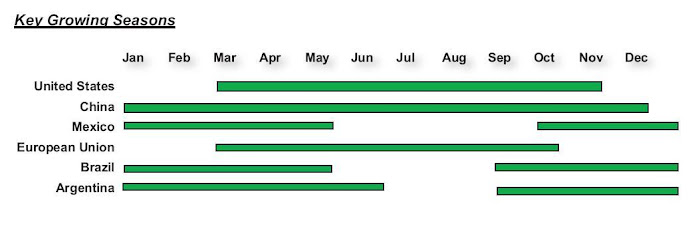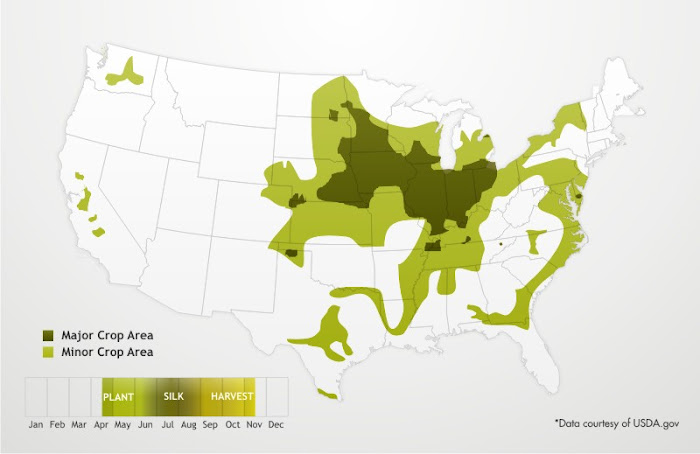traderkenny
Active member
- Messages
- 106
- Likes
- 4
The Learn About Futures Insider: Corn
According to Chicago Board of Trade history, the earliest "forward" contract for corn was recorded in 1851. This essential grain has come a long way since then in both everyday applications and futures trading. Since the first Amerindians cultivated it, corn has been an essential food product for humans and livestock alike. Modern technology has seen corn elevated to an industrial and fuel product, changing the supply and demand dynamic and causing more than one debate as prices soared to record highs.
Contract Size: 5,000 Bushels
Price Quote & Tick Size: Cents per bushel; minimum fluctuation is ¼ cent per bushel ($12.50 per contract)
Contract Months: March, May, July, September, December
Trading Specs: CME Globex: 6:00 pm - 7:15 am and 9:30 am - 1:15 pm central time, Sunday - Friday Central Time
CBOT Open Outcry: 9:30 am - 1:15 pm Monday - Friday Central Time
Daily Price Limit: $0.30 per bushel expandable to $0.45 and then to $0.70 when the market closes at limit bid or limit offer. There shall be no price limits on the current month contract on or after the second business day preceding the first day of the delivery month.
Trading Symbols: Open Outcry - C; Electronic - ZC

Past performance is not indicative of future results.
***chart courtesy of Gecko Software
Corn Facts
Since corn is produced in both the Northern and Southern hemispheres, there can be news all year round pertaining to crop development. Some of the key areas have growing seasons or crop years as follows:

The actual time from planting to harvest can vary by a few weeks and flooding and cold weather may cause delays. However, these growing season notes can be used as a reference point when considering key news events for corn.
In the US, the key planting regions and growing times can be illustrated as follows:

According to the U.S. Department of Agriculture (USDA), production, imports, and exports for corn have recently been distributed per the following charts:

Past Performance is not indicative of future results. Chart data courtesy of the USDA.

Past Performance is not indicative of future results. Chart data courtesy of the USDA.

Past Performance is not indicative of future results. Chart data courtesy of the USDA.
Key Terms
Silk - Stigmas of the corn plant. Each silk connects to a potential kernel on the ear of corn and needs to be pollinated. Successful pollination usually occurs 4-5 days after the silk emerges. Moisture deficits can affect silk emergence. Certain beetles can also "clip" the silk.
Ethanol - Ethyl alcohol used for fuel. Corn gets about 2.7 gallons of ethanol per bushel. In recent years, around 17 percent of the corn crop in the US went to ethanol production.
Yield - In terms of growing corn, yield is usually expressed as bushels per acre. An acre is over 43,000 square feet. In Iowa, farmers might harvest upwards of 170 bushels per acre.
Metric Ton (MT) - Also known as tonne, is the accepted unit of mass for 1,000 kilograms (2,205 lbs.)
Key Uses
Ethanol - According to information from the National Corn Growers Association, 2.3 billion bushels of corn were used to produce 6.5 billion gallons of ethanol fuel in 2007. By-products of ethanol production include livestock feed for beef and dairy cattle, swine, and poultry.
Food Products - Corn is used in everything from corn chips and corn meal to starch, syrup, whiskey, yogurts, margarine, mayonnaise, and beverages. Corn starch provides an important component for cakes and cookies while corn syrup sweetens carbonated beverages and gives chewiness to candies.
Livestock Feed - It is estimated that 55 to 60 percent of the annual corn crop in the United States is used as livestock feed.
Thousands of other Uses - Ground corn cobs - relatively dust free and highly absorbent - are added to cosmetics. Resin from corncobs is used as solvents in dyes and lacquers. Starch is used in the production of spark plugs and rubber tires. Textiles can be produced from a corn fiber similar to polyester.
Key Concerns
Like most agricultural products, corn needs sufficient quantities of adequate weather, moisture, fertilizer (potash and nitrogen), and pesticides.
Key stages for the growth cycle, which for most corn hybrids is around 110 days for optimal yields, include:
Planting - this stage focuses heavily on soil moisture levels
Germination - Adequate soil moisture and temperature are critical to ensure germination.
Growth to Harvest - Once the corn plant has been established, weather and insects have marginal effect. During the four week pollination period, the corn plant is extremely vulnerable to drought. Early frost can interrupt the kernel filling and drying stages while extreme cold affects quality.
Pests and Disease - Corn diseases include downy mildew, stalk and kernel rot, common rust, brown leaf spot, and northern corn leaf blight. Diseases are usually divided into four general groups according to the affected plant part; seedling and root diseases, leaf diseases, stalk rot diseases, and ear rot diseases. Corn plants naturally have effective genetic resistance to many diseases and controls include planting resistant hybrids, crop rotation, and fungicides.
Pests include European corn borer, rootworm larvae, and black cutworm. Again, select hybrids can be used in management as well as insecticides.
_______________________________________________________________________________________
Disclaimer: There is a substantial risk of loss in futures trading and it is not suitable for all investors. Losses can exceed your account size and/or margin requirements. Commodities trading can be extremely risky and is not for everyone. Some trading strategies have unlimited risk. Educate yourself on the risks and rewards of such investing prior to trading. Futures Press Inc., the publisher, and/or its affiliates, staff or anyone associated with Futures Press, Inc. or www.learnaboutfutures.com, do not guarantee profits or pre-determined loss points, and are not held monetarily responsible for the trading losses of others (subscribers or otherwise). Past results are by no means indicative of potential future returns. Fundamental factors, seasonal and weather trends, and current events may have already been factored into the markets. Information provided is compiled by sources believed to be reliable. Futures Press, Inc., and/or its principals, assume no responsibility for any errors or omissions as the information may not be complete or events may have been cancelled or rescheduled. Any copy, reprint, broadcast or distribution of this report of any kind is prohibited without the expressed written consent of Futures Press, Inc.
